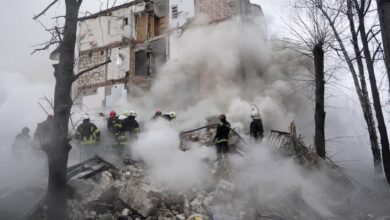The ‘kamikaze’ weapons Israel’s soldiers will fear most in Gaza

When thousands of Hamas militants crossed into Israeli territory through the most militarised border fence in the world on 7 October, few understood how such a feat was possible.
The multilayered Gaza border fences are roughly seven metres tall and replete with high-tech sensors, remote-controlled machine guns, cellular communication stations and surveillance towers roughly every two kilometres.
How could those within what is considered an “open air prison”, their imports thoroughly vetted, overcome a state-of-the-art fence purpose built to keep them in?
The short answer: drones.
Hamas initiated their 7 October attack by firing 35 single-use attack unmanned aerial vehicles (UAVs) at the border fence, according to a statement by the group’s military wing.
In so doing, they disabled parts of the Israeli communications equipment, preventing the duty officers from monitoring the area remotely with video cameras, and destroyed many of the remotely-controlled machine guns designed to empower soldiers to prevent incursions from afar.
That bought Hamas a brief window to move into Israel, but that was all they needed. The world knows well what happened afterwards.
The rise of Hamas from an offshoot group in Egypt to the governors of Gaza has closely coincided with the proliferation of drones, both commercial and within militaries.
Ukraine provided the first real-world example at scale of the effectiveness of modified commercial drones on a battlefield. Hamas has just provided the second example.
In the past few years, the militant organisation turned de facto leader of Gaza has been building a significant arsenal of commercial drones while working closely with its Iranian backers to acquire military-grade systems.
Israel is considering this aerial risk carefully in preparation for their anticipated ground offensive into Gaza. The threat to life these systems pose make this possible incursion one of the most dangerous in decades, according to experts, as well as one of the most difficult.
Drones proved integral to the beginning of this conflict; they may just define its conclusion.
What drones do Hamas have?
There are three overall types of aerial drones Hamas can use against Israel during a possible incursion, according to Federico Borsari, an expert in unmanned technologies.
These include single-use, fixed-wing kamikaze UAVs, loitering munitions, equipped with video cameras and radio links, known as “suicide drones” by Hamas, and commercially-available quadcopters used for surveillance and reconnaissance, supply runs and dropping munitions.
Israeli soldiers work on a tank at a staging area near the border with the Gaza Strip
1. Single-use drones
These are fixed-wing drones guided by GPS-based navigation systems, or inertial systems, that “become one-way attack UAVs that can be directed towards stationary targets, such as infrastructure and military bases”, Mr Borsari said.
They are not equipped to provide live feeds, like other drones, which means they cannot hit moving targets.
“They have been produced much more in the last few years and they are very effective when used in large numbers,” Mr Borsari said. “If they reach their target, they can have a substantial effect. We are talking about hundreds of drones probably that Hamas have already prepared and stocked.”
A Ukrainian soldier of 24th brigade prepares equipment of FPV drones
Hamas posted to Telegram photos purporting to show its quadcopter-dropped munitions





